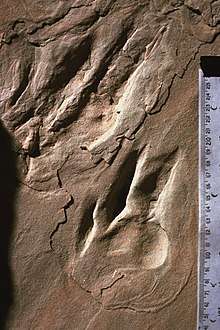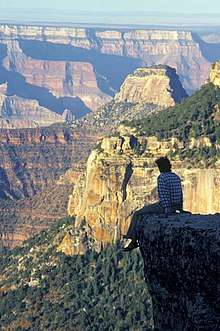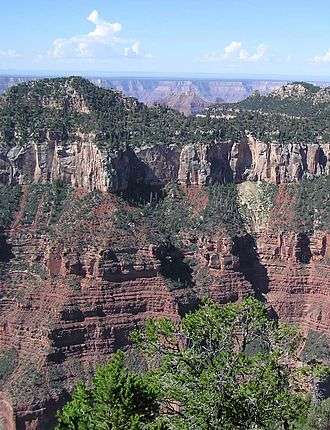Coconino Sandstone
Coconino Sandstone is a geologic formation named after its exposure in Coconino County, Arizona. This formation spreads across the Colorado Plateau province of the United States, including northern Arizona, northwest Colorado, Nevada, and Utah.

| Coconino Sandstone Stratigraphic range: Permian | |
|---|---|
| Type | Sedimentary |
| Sub-units | Harding Point Sandstone Member, Cave Spring Sandstone[1] |
| Underlies | Kaibab Limestone, Toroweap Formation |
| Overlies | Hermit Formation |
| Lithology | |
| Primary | Sandstone |
| Location | |
| Region | Colorado Plateau |
| Country | (Southwestern United States) |
| Extent | |
| Type section | |
| Named for | Coconino Plateau |
| Named by | N. H. Darton, 1910[2] |


This rock formation is particularly prominent in the Grand Canyon, where it is visible as a prominent white cliff-forming layer. The thickness of the formation varies due to regional structural features; in the Grand Canyon area it is only 65 ft thick in the west, thickens to over 600 ft in the middle and then thins to 57 ft in the east. Either the Kaibab Limestone or Toroweap Formation overlies the Coconino Sandstone. The Coconino Sandstone is typically buff to white in color. It consists primarily of fine well-sorted quartz grains, with minor amounts of potassium feldspar grains deposited by eolian processes (wind-deposited) approximately 275 million years ago. Several structural features such as ripple marks, sand dune deposits, rain patches, slump marks, and fossil tracks are not only well preserved within the formation, but also contribute evidence of its eolian origin.[3][4][5]
Lechatelierite (silica glass), as well as coesite and stishovite (high pressure forms of SiO2) were formed during the impact of a meteorite into the Coconino Sandstone at Barringer Crater in Arizona.[6][7]
Geological sequences

white Coconino on eroded slope of Hermit Shale upon resistant & sloping Supai Group-”redbeds”.
Sequence of layers: Coconino Sandstone on Hermit Shale on sloping redbeds of Supai Group.
See also
| Wikimedia Commons has media related to Coconino Sandstone. |
- Geology of the Grand Canyon
- Natural history of the Grand Canyon
- Permian geologic formations
References
- Blakey, R.C. (1990) Stratigraphy and geologic history of Pennsylvanian and Permian rocks, Mogollon Rim region, central Arizona and vicinity. Geological Society of America Bulletin. 102(9):1189-1217.
- Darton, N.H. (1910) A reconnaissance of parts of northwestern New Mexico and northern Arizona. Bulletin 435. U.S. Geological Survey, Reston, Virginia. 88 p., (incl. geologic map, scale 1:1,000,000)
- McKee, E.D. (1945) Small-scale structures in the Coconino Sandstone of northern Arizona." The Journal of Geology. 53(5):313-325.
- McKee, E.D. (1979) A study of global sand seas. Professional Paper 1052. U.S. Geological Survey, Reston, Virginia. 429 pp.
- Middleton, L.T., D.K. Elliott, and M. Morales (2002) Coconino Sandstone, in S.S. Beus and M. Morales, eds., Grand Canyon Geology. Oxford University Press, New York, New York. ISBN 0-19-512299-2
- Kieffer, S.W. (1971) Shock metamorphism of the Coconino sandstone at Meteor Crater. Arizona, Journal of Geophysical Research. 76(23):5449-5473.
- Kieffer, S.W. (1971) I, Shock Metamorphism of the Coconino Sandstone at Meteor Crater, Arizona; II, The Specific Heat of Solids of Geophysical Interest. Unpublished PhD. dissertation. Department of Geological and Planetary Sciences, California Institute of Technology, Pasadena, California. 253 pp.
External links
- Anonymous (nd) Coconino Formation, Geological Formations−Records of the Past, West Coast Regional Carbon Sequestration Partnership (WESTCARB).
- U.S. Geological Survey (2011) Coconino Sandstone, Stratigraphy of the Parks of the Colorado Plateau, U.S. Department of the Interior, Denver, Colorado.